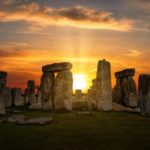Have you ever noticed that days are long and warm in the summer and short and cold in the winter? Long summer days seem to stretch into the late hours of the night, while nightfall in the wintertime begins right around dinner time. If you’ve ever wondered what causes days to get shorter and nights to last longer in the winter, you’ve wondered about ‘solstice.’
We all know that the Earth revolves (moves) around the sun. You might imagine the Earth sitting as straight as an astronaut strapped in a chair inside a rocket, moving around our star without a wobble. The Earth does not sit straight up, though. It sits at an angle, tilting slightly. While you can draw a straight line from the northern-most point of the planet to the southern tip, they are not equal distances from the sun.
This image shows how the earth’s axis tilts
The top of the Earth (the North Pole) does not always tilt toward the sun. It stays in the same position. So, as the planet revolves, sometimes it tilts toward the sun and sometimes the North Pole tilts away.
When the northern part of the Earth is tilted toward the sun, days in the Northern Hemisphere of the Earth are longer. The temperature is warmer. Summer comes to that half of the planet. Because they get most of the sun’s light and warmth, the season changes and things begin to grow. The equator (the exact middle of the Earth measuring from top to bottom) is always the hottest area, but even those places warm in the summer. Six months later, when the Earth has revolved half-way around the sun, the North Pole is tilted as far away from the sun as it ever gets. Days are shorter and the temperature is colder. Winter comes.
When the northern hemisphere is away from the sun, this region experiences winter
But what is going on down south? The Southern Hemisphere is experiencing summer! Because their pole is now close to the sun, their temperatures rise and days lengthen.
The two halves of the Earth are always in opposite seasons. Places like Australia, South America and Africa experience summer while North America, Europe and most of Asia are cold!
There is one day each year when the Northern pole of the Earth is closest to the sun. That day falls on June 21-22. That day is called the Northern Solstice. On December 21-22, the Southern Solstice, the southern point of the planet is closest to the sun. The Solstices are more commonly called ‘the Summer Solstice’ and ‘the Winter Solstice’, but that can get confusing, since summer and winter fall in different parts of the year, depending on which hemisphere you live in.
Solstice means ‘sun standing.’ To astronomers (people who study the stars) long ago, it appeared that the sun moved around the Earth. On the two days of solstice, they believed that the sun was standing still because the measurement of the sun from the horizon stopped rising and began to fall again. Then, six months later, it happened again.
We now know that it is the Earth that moves. But on the days when the northern or southern tip of the Earth is tilted closest to the sun, we still celebrate the Solstice.






